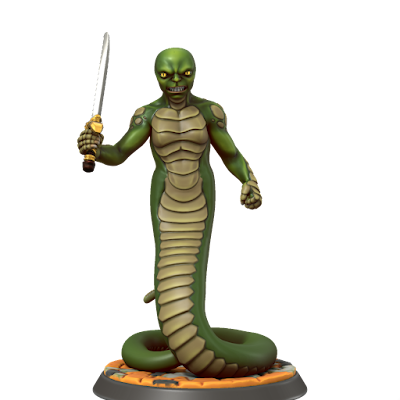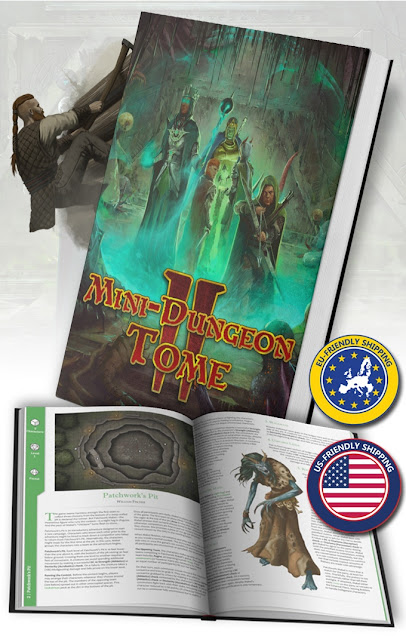The gaming magazine is dead. After all, when was the last time that you were able to purchase a gaming magazine at your nearest newsagent? Games Workshop’s White Dwarf is of course the exception, but it has been over a decade since Dragon appeared in print. However, in more recent times, the hobby has found other means to bring the magazine format to the market. Digitally, of course, but publishers have also created their own in-house titles and sold them direct or through distribution. Another vehicle has been Kickststarter.com, which has allowed amateurs to write, create, fund, and publish titles of their own, much like the fanzines of Kickstarter’s ZineQuest. The resulting titles are not fanzines though, being longer, tackling broader subject matters, and more professional in terms of their layout and design.
—oOo—

From the off,
Knock! An Adventure Gaming Bric-à-Brac grabs the reader’s attention and starts giving him stuff. Open the book and there is the beginning of an adventure on the front folded flap of the dust jacket. Slip that off—a dust jacket on a paperback book, no less!—and the adventure continues so that the reader can run its adventure separate from the actual book. Flip through the pages of the book and the reader will be impressed not by the range of content, but the look of the thick booklet. Heavily illustrated with a mix of artwork, both publicly available and new, there are think pieces and opinion pieces, tables galore of almost everything and anything imaginable, Game Master advice, new twists on old ideas, new ideas about old monsters, new monsters, new Classes, and even an adventure or three. And all of it for the Old School Renaissance and the Retroclone of the reader’s choice. Some of the content has been drawn from blog entries written by the leading luminaries of the Old School Renaissance, but since the publication of
Knock! #2 An Adventure Gaming Bric-à-Brac there has been less of this and the mix of the old and the new has been more balanced. Published by
The Merry Mushmen, each issue of promises and delivers oodles and oddkins of and for Old School Renaissance, making it a very companionable cumulation ready for the Game Master’s consultation.
Knock! #3 An Adventure Gaming Bric-à-Brac was published in June, 2022 following a successful
Kickstarter campaign. The contributors for this issue, just to give you an idea of its range include Alexandre ‘Kobayashi’ Jeanette, Andrea ‘Vyrelion’ Back, Antoine Bauza, Arnold K., Ava Islam, Bill Edmunds, Brent Edwards, Christopher S., Ciro Alessandro Sacco, Danilo Moretti, David McGrogan, Diogo Nogueira, E. A. ‘taichara’ Bisson, Eric Brimstin, Eric Nieudan, Frank Reding, Harbowoputra, Islayre d’Argolh, Jack Shear, James Hall, James Holloway, James Malizsewski, Jason Sholtis, Jean Verne, John Grümph, Jorge Velasquez, Joseph Manola, Justin Hamilton, ktrey parker, Matt Strom, Nicolas Dessaux, Nobboc, Nyhur, Paolo Greco, Phill Loe, Pierre Vagneur-Jones, Roger SG Sorolla, Ron E. Ortiz, Rosie Grey, Stuart Robertson, Thomas Rey, Vagabundork, Vasili Kaliman, and Zach Howard aka Zenopus. There are some sixty articles and entries in the issue across a range of themes and ideas.
The scenario on the inside of the dust jacket for
Knock! #3 An Adventure Gaming Bric-à-Brac is ‘Valley of the Desert Hound’, a sandbox by Thomas Rey and Eric Nieudan for First and Second Level Player Characters. It describes a desert valley wherein the Desert Hound was imprisoned in ages past in a Cursed Ziggurat. Now home to bandits and a tribe of semi-feral Halflings, much of the valley is buried under sand and there is a ‘Liberal Archaeology Table’ to roll on any time the Player Characters decided to search the sands. The suggestion is that the adventure could be tied in with the
Basic Dungeons & Dragons module,
B4 The Lost City. The scenario comes with a table of ‘Rumours and Hooks’ too, so that the Game Master can get her players and their characters easily involved.
What strikes the reader about
Knock! #3 An Adventure Gaming Bric-à-Brac is its array of tables. There are tables upon tables and whole articles of tables and tables that are whole articles in the issue. For example, David McGrogan asks ‘What Happened to the Bodies?’ and gives a table of options what happens to the bodies of the humanoids and the large monsters after the Player Characters have put them to the slaughter. Its counterpart by Andrea ‘Vyrelion’ Back is ‘I slit open the body’, a table of contents of the stomach or intestines of some great beast. Andrea ‘Vyrelion’ Back adds flavour and fun to the Kobold with ‘d8 Weird Kobold* Weapons’ with entries like ‘Stink-n-Poke’, which inflicts low damage but marks the target with a stench that never really quite goes away or a ‘Burning Blade’, which is a bone blade covered in hot pepper powder! ‘What are my rations?’ by Eric Brimstin gives detail and verisimilitude to something that is otherwise incredibly mundane and always overlooked in
Dungeons & Dragons.
Knock! #3 An Adventure Gaming Bric-à-Brac does not have a theme, but there are themes to be found. The most obvious one is that of ‘Domain-level’ play, which comes about when the Player Characters reach Ninth and Tenth Level and switch their focus from adventuring to maintaining a realm or institution of some kind. ‘Revisiting the Domain Game’ by Jack Shear gives options for making it interesting by giving a table of unavoidable issues and unruly neighbours, whilst Joseph Manola dives into the subject in more detail with ‘Meet the new BOSS – 7 thoughts on domain-level play’ with advice on how to run such a campaign. This is born of his own campaign in which the players and their characters have switched focus to ignore adventuring. The advice is excellent covering problem solving, keeping it OSR-style, turning threats into resources, and more. Similarly, Christopher S. creates dragons through ‘The Seven Draconic Sins’ to give them personality and motivation, Ava Islam suggests ways of making dragons more interesting in ‘Playing Dragons’, and in ‘Humanising the Monster’, Brent Edwards presents means of combining humanising and monstrous traits to make them fathomable, all three articles forming a draconic strand.
The advice and thoughts on
Dungeons & Dragons begin with ‘The Story is the Campaign’ by David McGrogan, which suggests that the play of the roleplaying game and the story that it creates is not about the Player Characters per se—although they star, of course—but about the overall campaign. He draws parallels with soap opera and its ongoing series of stories which end and are replaced by another, as well its characters who also come and go. Of course, in the soap opera, their transience is driven by the writers and the story, but in
Dungeons & Dragons, it is typically driven by Player Character death—which is the starting point for the article. James Maliszewski draws similar parallels in his ‘Picaro and the “Story” of D&D’, distinctly dividing
Dungeons & Dragons between its original picaresque style of play and the heroic individualism and story focus of the post-Dragonlance era. He contends the original style of play is pulp-ish, if not outright pulp fantasy, the Player Characters are roguish, and the further the roleplaying moves away from this, the more it breaks and deviates from its roots. It a very Old School Renaissance stance, but clearly explained and relatable. The advice includes Diogo Noguiera’s ‘(My) Ten Commandments For Good Refereeing’ and Arnold K.’ s ‘Dynamism and the Generic Optimum’, which dangerously modish from its title, but really suggests ways of making dungeon exploration exciting and challenging by adding dynamism, whether through random events, increased difficulty, adding a unique element, and more. This is in and out of combat. Of course, these are articles whose type we have seen again and again, both before the advent of the Old School Renaissance and after, and the ideas are still interesting and the advice sound.
The volume is full of good articles, but some of the more fun and more inspirational ones include Joseph Manola’s ‘When All You Have Is a Hammer – Item-based problem solving’ which takes the act of a player consulting his character sheet for the means to solve a problem—often with weapons or magic—as a spur to provide interesting treasures that the Player Character might otherwise sell, but when noted on the character sheet could be used to solve a problem and let the player be inventive. For example, “Broad-brimmed fisherman’s hat. Waterproof and wide enough to conceal most of the wearer’s face. Could be used as an improvised boat for carrying small objects across water.” or “A fiery political tract, full of stirring revolutionary rhetoric cataloguing the crimes of the ruling classes and calling upon the people to rise up. Handy if you want to rile up a mob in a hurry.” All have a monetary value, but all have other uses if the players think about it. Warren Denning answers that age-old question, ‘What To Do Now That Your 1st Level Magic-User Has Cast Their One Spell?’ with not exactly new suggestions, but they are spelled out in detail and do give that poor wizard something else to do, whilst Frank Redding’s ‘Compelling Arena Fights’ does a fine job of making arena fights exciting with plenty of variations.
One of the most interesting articles in the issue is ‘Jennell Jaquay’s The Caverns of Thracia – Appreciation, Critique, and DM User Guide’. This is a fascinating guide by Roger SG Sorolla to one of the classic modules to be published by Judges Guild. The other, of course, is
Dark Tower, and both are, of course, designed by Jennell Jaquay. This is a detailed breakdown of the adventure, its history, quirks, nature, and the challenges that a Referee will be faced in running one of the larger adventures published by Judges Guild. It is a thorough analysis, its often-scholarly tone at odds with the rest of the issue. It does feel a little compact in places, but this an excellent piece well worth reading by anyone interested in the history of
Dungeons & Dragons and the Referee preparing to run the adventure. More articles like this would add a little more thoughtful heft to the magazine.
The last quarter of
Knock! #3 An Adventure Gaming Bric-à-Brac does settle down and become more focused as it organises its content into regular departments. The ‘Portfolio of Cartographic Curiosities’ contains seven maps, all absolutely beautiful pieces that you could just sit there and look at, appreciating their artistry, whilst at the same time wishing that you had the time to use them to create adventures (or more likely, someone else had the time). One niggle is that two of the maps are in French, having been originally published in a d20 System magazine. One of them has lots of text and it would have been nice if that text had been translated. This is followed by the Menagerie of Monstrosities which provides seven new monsters (in addition to those already given or discussed in in the volume, such as ‘What Are Those Stirges Doing?’, Ktrey Parker’s table of making Stirges more interesting than just vermin) that start with the Herdling by Nobboc, half-human, half-cattle folk that are amiable and will trade secrets for trinkets and even a portion of their flesh, which provides certain benefits upon consumption. This has just a little (if not more) of the Ameglian Major Cow or ‘Dish of the Day’ from Douglas Adams’
The Restaurant at the End of the Universe. James Holloway, of
The Monster Man podcast offers the Homunculites, tiny Halfling-sized magically-created worker, soldier, or based on some artificial humanoids. Almost clone-like, these chibi-style monsters are rather silly in their way and sure to infuriate certain players. James Maliszewski describes two monsters, the Blighter, disease-ridden undead which spread contagion, and the Eidolon, undead spirit of a cleric who died while in the grips of despair, no longer finding solace in True Faith, whilst the Birch Maiden by Danilo Moretti, cousin to Dryads, provides a nice variation upon the latter.
‘Retinue of Rogues’ details six new Classes. Nobboc’s ‘The Lost Droid’, a humanoid robot crashlanded onto a fantasy world, its memory banks wiped clean. As it advances in Level, it activates Techno-modules like Force Field or Echo Radar 3000, each of which has a Usage Die
a la The Black Hack. This is an entertaining Class should the Game Master wants to take her campaign into the realms of Science Fiction or Science Fantasy. Vagabundork’s ‘The Rat Catcher’ is an obvious nod to the Career from
Warhammer Fantasy Roleplay, but here given advantages when it coms to dungeoneering, such as being able to find his way round sewers and catacombs, track vermin (including Kobolds and Goblins, as well as Rats), and possessing a certain danger sense. ‘The Blemmye’ by Pierre Vagneur-Jones is a headless humanoid—its head is in its chest—that best works with an attending group of retainers, whilst Eric Nieudan’s ‘The Lazer Mage’ is an Illusionist who can convert spell slots into explosive beams, holograms, laze swords, and light flashes. The accompanying illustration suggests that the Marvel Comics character, Dazzler, is the inspiration. ‘The Space Vampire’ by Jack Shear is intended to be vampy and campy, feels more suited to a
Hypertellurians: Fantastic Thrills Through the Ultracosm-style game. Lastly, James Maliszewski’s ‘The Chenot’ is a plant-like humanoid, tiny, who can perform certain abilities such as ‘Climb sheer surfaces’, ‘Find or remove traps’, and so on with its tendrils. Again suited to weirder campaign settings, it could just be another alien species, if the setting is more Science Fiction or Science Fantasy than fantasy.
‘Extraordinary Excursions’ includes three adventures. The first is ‘Imprint’ by Jason Sholtis. This is set in ape-haunted Upper Mastodonia, the location for the brilliant
Operation Unfathomable adventure and now its fully detailed setting explored in
Completely Unfathomable. Described as an ‘Open Air Dungeon’, It is a miasmic-filled, lethally contaminated deression left behind by a titanic being from another place which left behind sloughed-off corporeal tissue (now decomposing) and alien gold, setting up a race to grab the lot by various factions. It is weird and pulpy, with Sci-Fi elements that provides a taster of the
Odious Uplands setting, but really works in conjunction with the campaign setting. James Hall’s ‘Titan Cliffs’ begins with the hands and face of a gigantic statue of a Titan emerging from the ground. Surely something worthy of exploration, especially after cloaked figures have been seen entering the Titan’s mouth. The dungeon, relatively small, is all contained within the Titan, and also being explored by a cult attempting to revive the Titan. There is nice sense of ‘magic as technology’ here, but the villains of the piece are underdeveloped. Lastly, ‘Nexus of the Ixx’ by Nicolas Dessaux is another Science Fantasy scenario, this time inspired by Barbarella. So, it is campy and it is mature in tone, the ‘dungeon’ being dedicated to a goddess of love. Thankfully, the scenario avoids anything prurient, but there are probably a limited number of campaigns or settings into which it will fit.
Physically,
Knock! #3 is impressively bright and breezy, just as with the previous two issues. The layout is a little cluttered in places and the text a little too busy, but on the whole, it looks good. It needs an edit in places, but the artwork is good and the cartography excellent.
Knock! #3 An Adventure Gaming Bric-à-Brac is another good, but not perfect issue. A very great deal of the issue could easily find its way into the campaign of any Referee, but not the scenarios, either because they have their own setting or because their tone is just not quite right for most campaigns. That aside, there is so much in the pages of the issue which is interesting, entertaining, or just fun.
Knock! #3 An Adventure Gaming Bric-à-Brac contains a wealth of inventive content, and just as with the first two issues, is another great addition to the shelf of any Old School Renaissance Referee.
—oOo—
An unboxing of
Knock! #3 An Adventure Gaming Bric-à-Brac can be viewed
here.






















